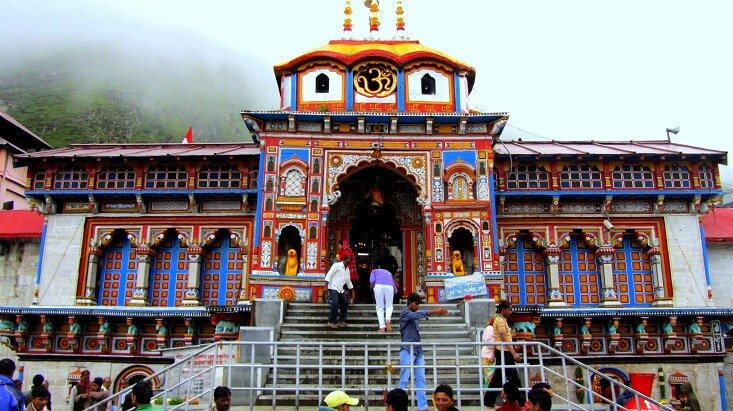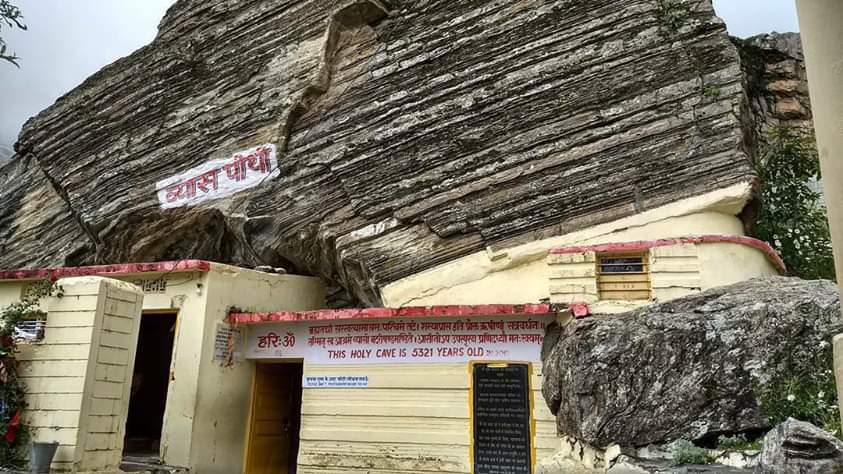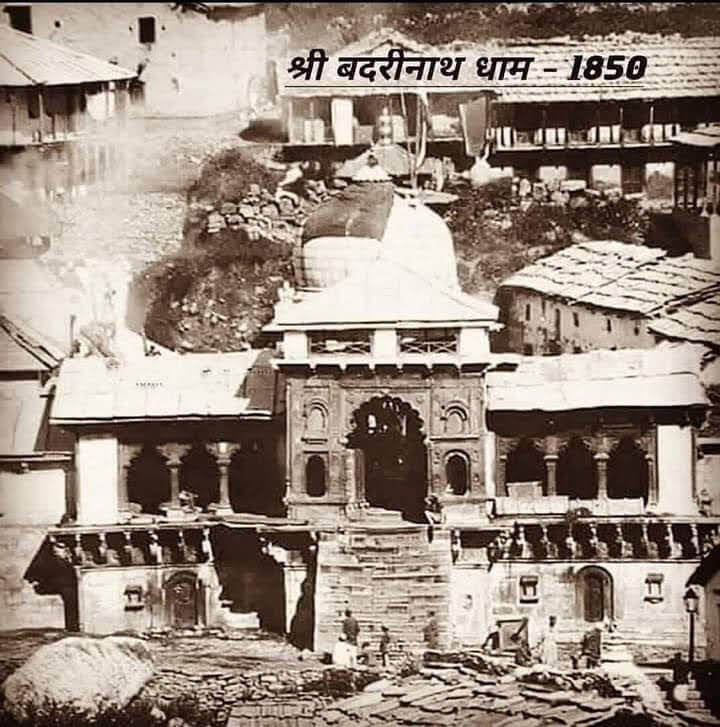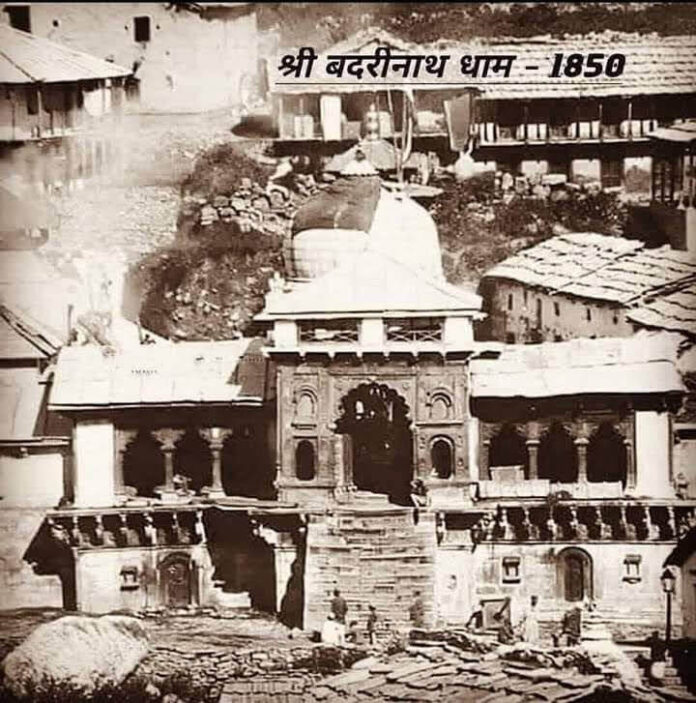Badrinath Temple is a Hindu Temple dedicated to Lord Vishnu, it is located in Garhwal hill tracts along the banks of the Maa Alaknanda River in Chamoli District in Uttarakhand. Badrinath temple history shows us many legends of Lord Vishnu and according to these legends it is also known as Badrinarayana.
Badrinath Temple is situated at 3,133 m (10,279 ft) above sea level and is located opposite Nar Parvat (Nar Hill), while the Narayana Parvat (Narayan Hill) is located behind the Neelkanth peak.
History of Badrinath Temple

The Land of Shri Badrinath (Badrikashram) recognized as Astam Baikuntha (वैकुण्ठ) in the universe is the one who is presided over by Lord Vishnu himself.
The Dham of Satyug is Badrinath, Rameshwaram of Treta, Dwarka of Dwapar, and Jagganathpuri have been recognized in Kaliyuga. These four places are also known as the famous Char Dhams of India
Ancient & Vedic History of Badrinath Temple
Badrinath temple history shows us this ashram (Badrikashram) of Lord Nar-Narayan has been an important center of Vedic culture since ancient times.
Due to its beautiful and rich surroundings, this Area of the middle Himalayas was called “Badarikashram” in ancient times.
Badrinath has been called by different names in different periods of the universe. Badrinath is mentioned in the slokas of Skanda Purana as Badrikashram.
One of the Slok from Skand Purana mentions Badrinath as follows;
कृते मुक्ति प्रदा प्रौक्ता त्रेतायां योग सिद्धिदा।
विशाला द्वापरे प्रोक्ता कलौ बदरिकाऋमः।।स्कन्द पुराण, 2/1/57
The meaning of the above Sanskrit Sloka is,
“The Ashram of Lord Narayan was called Muktiprada in Satya Yuga, Yogasiddha in Treta, Vishala in Dwapar and Badrikashram or Badrinath or Badri-Vishal in Kali Yuga.”
Notable Legends about Badrinath Temple
Here are the legends and stories related to the history of the Badrinath temple.
Ved Vyasa in Badrinath (The Cave of Veda Vyasa):
Badrinath is the same place where Ved Vyasa divided the Vedic Samhitas into several sections and sorted each subject by separating the various mantras.
The cave of “Ved Vyas Rishi” is located in Badrinath itself. This cave is under a huge stone 200 meters above Mana Village. This cave is around more than 5000 years old.

There is a written sign in Devanagari as “Vyasa Pothi” which literally means written text (books) by Vyasa. It is said that Lord Ganesha also visited this place to help Veda Vyasa in his writing works.
There is a cave of Lord Ganesha (Ganesh Gufa) that is present there just 100 meters before the Cave of Ved Vyasa (Vyas Gufa) in Mana village of Badrinath.
It’s said that Ganesha wrote the Mahabharata at the request of Veda Vyasa. There are 1.8 million words in Mahabharata written by Ganesha and it was recited to him by the sage Vyasa (Veda Vyasa).
Mahabharat is the longest poem in the world ever written, as it consists of 100,000 śloka or over 200,000 individual verse lines (each shloka is a couplet).
Sage Ved Vyasa lived in this cave and composed Asta-das Puranas like Bharat Samhita, Mahabharata, Shrimad Bhagwat, etc. He also composed eighteen Puranas in this cave.
Other Important Legends about Badrinath:
- Markandeya in Badrinath: The penance and the place of action of Markandeya Rishi were also Badrikashram. The rock on which he used to sit is still known as Markandeya Shila.
- Lord Ram in Badrinath: Lord Ram also reached here at Badrikashram (Badrinath) to worship Lord Narayan.
- Pandavas in Badrinath: According to “Mahabharata Vana Parva” (Section 134/19/21), there is a mention of the Pandavas’ visit to Badarikashram.
Bheempul near Vyas Gufa: On his way to heaven, Mahabali Bhima (one of the brothers from Pandavas) raised a huge stone rock and built a bridge to cross the Saraswati river at this place. Hence it is known as Bhim Pul.
The Pandavas crossed the Saraswati River by crossing this bridge.
- Tulsidas in Badrinath: Goswami Tulsidas went on a journey to Kailash-Mansarovar via Badrikashram at the end of the sixteenth century.
In a verse of Vinaya Patrika, Tulsidas mentioned the very tough travel route of Badrikashram (Badrinath) and wrote that “On this path, only with the help of the strength of religion and the system of abstinence, the traveler can move ahead by saving his life.”
- Badrikashram (Thiruvadhari Ashramam) is one of the 108 Divyadesam dedicated to Vishnu, who is worshipped as Badrinath.
Legends of Buddhism with Badrinath
Rahul Sankrityayan (Kedarnath Pandey, Writer) calls the statue of Badrinath the statue of Buddha.
But historian Dr. Shiv Prasad Naithani does not consider it logical to see Buddhism in the statue of Badrinath on the basis of many facts.
According to him, wherever there are practices of Buddhism in the Himalayan region in Uttarakhand, they are all medieval, not ancient.
Many of these statues were attacked and snatched from the monasteries of Tibet.
History of Other Char Dham Temples
Establishment of Badrinath Temple

A story is prevalent in relation to the establishment of Badrinath, that once Lord Shankar was traveling to the Himalayas with Mother Parvati.
They saw a little child crying in the middle of Badrinath Marg. Mother Parvati stopped in pity and she lifted the crying child in her lap. That Child stopped crying and start smiling and then the child appeared in the four-armed form of Lord Vishnu.
After that Lord Vishnu requested Lord Shiva and Mother Parvati with urgency and said Lord, all this Kedarkhand is your holy Area, so Please give shelter to me also under this holy area.
As a result of the consent of Shiva-Parvati, this Badrikashram area became the biggest pilgrimage of Vaishnavism in this Shiva land.
There is a mention of the visit to Badarikashram by the Pandavas in the Mahabharat Van Parva (134: 19-21).
The Pandavas saw here the “Badri“ tree, whose stem was round, with smooth leaves, with dense shade, and the stream of honey used to flow in the divine fruits of this tree.
Who Built Badrinath Temple?

According to mythic, Badrinath Temple was originally established and constructed as a pilgrimage site by Adi guru Shankaracharya in the ninth century to revive the lost prestige of Hinduism.
Shankaracharya excludes the idol of Lord Badrinath from Narad Kund and restored it and established Jyotirmath in the form of Atharvaveda monastery.
In order to protect and propagate Vedic religion, Shankaracharya established his monastery in all four directions of the country near these places of pilgrimage.
Jaggannathpuri in the east, Dwarkapuri in the west, Rameswaram in the south, and Badrikashram in the north were built under these four dams.
Hindu followers assert that he discovered the deity of Badrinath in the Alaknanda River and enshrined it in a cave near the Tapt Kund hot springs.
Explore Badrinath
How Badrinath Got its Name? (Meaning)
According to Hindu legend, god Vishnu sat in meditation at this place.
During his meditation, Lord Vishnu was unaware of the cold weather. Goddess Lakshmi, his wife, protected him in the form of the Badri tree.
Pleased by the devotion of Goddes Lakshmi, Lord Vishnu named the place Badrika Ashram. Hence Lord Vishnu was called the “Badri Vishal” as a large Beri/jujube and Lord Vishnu as “Badrinath” lord/husband of Badri.
History of Badrinath Priests
Before the arrival of Adi Guru Shankaracharya to Badrinath, in whose hands the worship system of Badrinath, there is no mention of it in history.
It is believed that in Vedic and Ancient times, Badrinath was worshiped by Siddha Gandharvas and Sages.
Shankaracharya excludes the idol of Lord Badrinath from Narad Kund and restored it and established Jyotirmath in the form of Atharvaveda monastery.
In order to protect and propagate Vedic religion, Shankaracharya established his monastery in all four directions of the country near these places of pilgrimage.
Jaggannathpuri in the east, Dwarkapuri in the west, Rameswaram in the south, and Badrikashram in the north were built under these four dams.
According to the arrangement of Swami Shankaracharya, Badrinath is worshiped by Brahmins of the “Namboodiri caste“ of South India, who are called “Rawal” or “Raval”.
Before Rawal, “Dandi Sanyasi Mahant” used to worship in Badrinath.
After the death of the last Dandi Mahant “Ramakrishna Swami“ in 1776, he had no successor, Therefore, the right of worship went out of the hands of the Dandi sannyasis and came into the hands of Raawals.
Complete Travel Guide
- Kedarnath Yatra 2023 Guide
- Badrinath Yatra 2023 Guide
- Gangotri Yatra 2023 Guide
- Yamunotri Yatra 2023 Guide
